When most people want a summer adventure they head out on the open road, but Brian Rooney set out on the open sea. Embarking on a 500-mile rowing trip with one of his oldest friends, Rooney explored small towns in New England and Canada, ate at local restaurants and learned a few lessons about travel, friendship and commitment.
My boyhood friend, Al Freihofer, and I are rowing from Kingston, Ontario 500 miles back to our summer homes on Lake George in upstate New York. Our route: The Rideau Canal to Ottawa, the Ottawa River to Montreal, the Lachine Canal through Montreal, the St. Lawrence River to Sorel and the Richelieu, then down to Lake Champlain and Lake George. This would be a challenge to anyone, but my friend and I are both 59 years old.
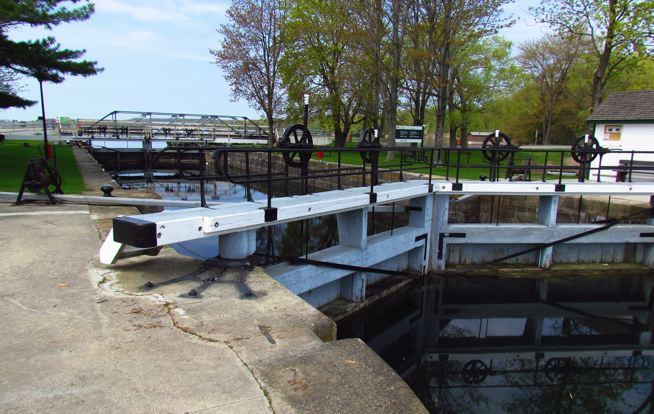
Rideau Lock
Our boats are 15-foot Adirondack guide boats, which look like canoes, but are not. The Adirondack guide boat is a double ended rowboat developed from the canoe, but rowed facing rear. It was designed with a big belly, which makes the boat more stable, and faster, as it is loaded down. People say to us “nice canoe” and then we have to explain.
The Rideau
We started out on the Rideau canal, which is more a chain of lakes connected by locks than an actual canal.
The Rideau was built 200 years ago and was the result of a monumental effort to build a supply route to defend Canada from attack by the United States. Of course, it was never used for that.
Almost all of the locks are as they were when the Rideau was built. A few are hydraulic, but the rest are manually operated with cranks and wheels. The lock keeper’s buildings are postcard-preserved white clapboard and stone. They have even preserved the block house fortifications with gun ports for shooting invaders.
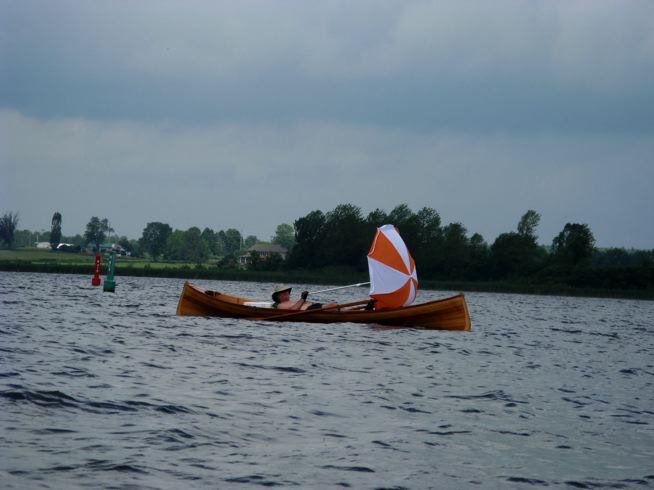
Canoeing is a tourist curiosity in the Rideau Locks
Unlike the Erie Canal, there are few canal towns and few people on the water, unless it is the height of the summer season.
Most of the time there are no restaurants, no convenience stores. Nothing.
On our fourth day, we stopped at Burrits Rapids, where we found a shower, laundry, and prime rib at the Lock 17 Bistro. It was karaoke night, and the place was rockin’.
Montebello
We have rowed 167 miles, total. Al says were dawdling. We stop for lunch at Château Montebello, which Margaret Thatcher once billed as the world’s largest log cabin and is now a resort. It’s big. We went through the eight locks of Ottawa yesterday. The Ottawa River is broad and muddy, running through a valley of farm land and low hills. We stopped on the French side for sandwiches in Bromont at La Petit Episserie, where they know what they’re doing.
The Ottawa River has taken us from the busy waters of Canada’s capital, buzzing with cigarette racers and boom box ski boats, to miles of emptiness. We go miles without seeing a person on shore or a boat on the water, then suddenly there is cluster of wind surfers.
Our journey has taken us through French-speaking Canada, where everyone is friendly despite the language barrier. We are impressed with how clean and well run everything Canadian seems to be. The public restrooms in the smallest town are clean. The park spaces are immaculately groomed. There is no garbage on the ground or in the water.
Explore the country for yourself in our Canada Travel section
Contrecoeur, Quebec
We rowed through an old industrial area of Montreal with some abandoned factories the size of Cathedrals. But even there the canal water was clean and lined with parkland and bike paths. We stopped for coffee, pastry and sandwiches at the Marche Atwater.
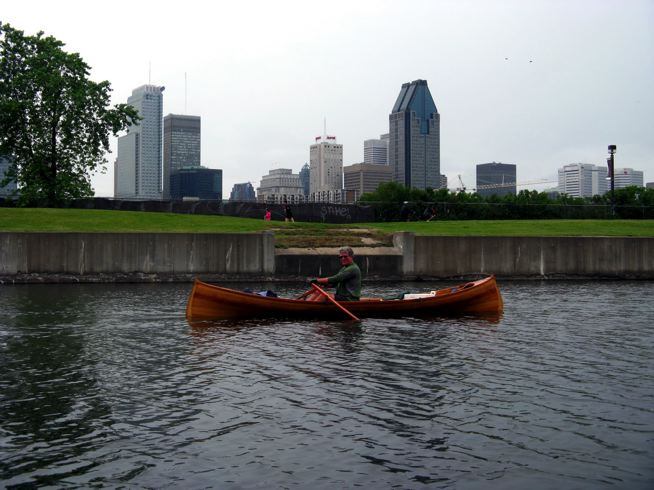
Brian rowing through the Lachine Canal in Montreal - photo by Al Freihofer
We were out there with the big boats and big water as we passed in view of downtown Montreal. The St. Lawrence took us through the port, where ships were and unloading, before giving way to countryside, and colonial Quebec. Occasionally you come across an old “moulin“, a stone silo-like building that was once a windmill.
We stopped to stretch our legs in a little town called Vercheres, where there was a statue of an heroic French pioneer woman holding a musket. We then camped in Contrecoeur, a little town with one main street and a pub. We negotiated tent space and a shower at the marina. This morning the proprietress of the little marina cafe brought us coffee and we drank it while listening to French music.
Lake Champlain
We crossed over from Canada this afternoon and made seven miles on Lake Champlain before pitching camp. We rowed past the ruins of Fort Montgomery, known as “Fort Blunder” at the Canadian border built to defend the US from the British, with its gun ports oddly facing South. It was never used and now it is North of the border.
Find your own aquatic adventure with our Water Sports section
We are beaten up by the Richelieu River, the river of no fun. The seawalls make the waves bounce back and for the first time, through storms and shipping lanes we were taking water over the side.
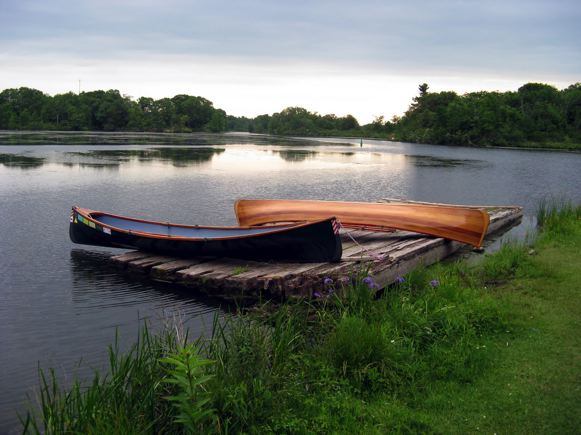 With nowhere to camp, we rowed until dark and reached the first lock where we camped on the lawn.
With nowhere to camp, we rowed until dark and reached the first lock where we camped on the lawn.
Saturday was more of the same. As light fell we were turned away from camping at a marina in Beloeil. We put on lifejackets and headlamps and were forced to row the strongest current on the river in the dark. At last we found a kayak club and got off the river at 10 p.m.
It was a relief to get off the Richelieu and on to Lake Champlain. We are getting close to home, rowing right up to our lakeside docks on Lake George, and falling into a real bed.
Burlington, VT
Lake Champlain has great geology where you can see the evidence of great turbulence. Some of the islands and points of land have vertical sedimentary layers where the land has been heaved.
We have also seen a lot of damage from the spring floods. A marina near the Canadian border was heavily damaged as are many waterfront homes. We passed a string of 18 beachfront homes that had all been damaged, one destroyed. The high water mark is about 4 feet above where we have been rowing.
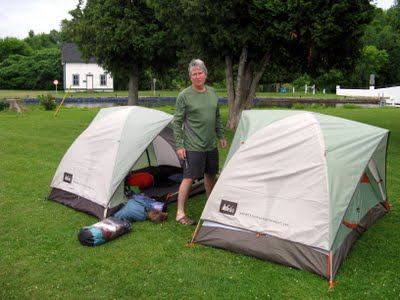
Camping in Burlington, Vermont - Al's back in spasms
Tuesday we set out from Chazy’s Landing and finally we came to a bay between two islands known as “the gut” and the Ladd’s Landing Marina. There Emily Clark took care of us, digging some chicken sausage out of the refrigerator, along with potato salad, and directed us to the barbecue on the lawn, where we cooked up a great lunch.
Our expedition went from near-cancellation to completion in a dramatic 24 hours. Wednesday afternoon we were on the public beach in Burlington with Al’s back in spasms. We woke the next morning and Al quickly discovered that his injury the day before had been caused by rowing all day in the stationary seat. He moved to the roller and was good.
We rowed up the La Chute River, which goes through downtown Ticonderoga. Al’s mother and friend Doug Livingston met us and we rolled our boats out of the public park, across a covered bridge and right through downtown Ticonderoga, past the waterfalls, the Aubuchon Hardware, and a mile uphill to the outlet of Lake George.
We rowed past Rogers Rock, to the 400-foot stone slope that Maj. Robert Rogers in legend slid down in winter to escape the French and Indians. We passed Hague, Silver Bay and Sabbath Day Point. We stopped twice to go swimming.
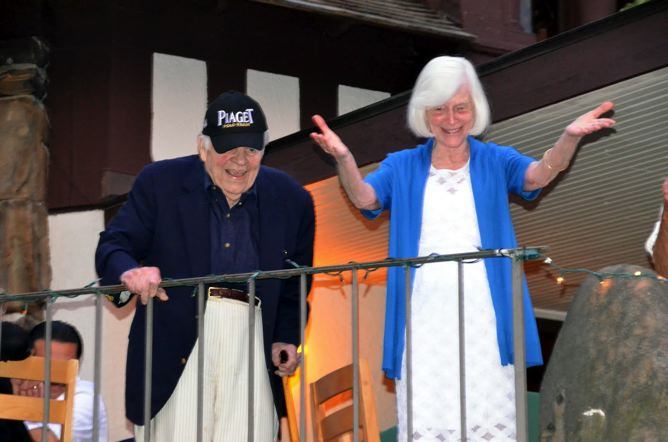
Brian's father Andy & friend Beryl hail their arrival at Lake George
Al was expressing doubts about the merits of even trying to get the Lake George Club for our celebratory dinner.
At the mouth of The Narrows, where the lake widens to the south, we were met with a headwind. It was like being at the base of Heartbreak Hill.
Eighteen days of rowing ended with one last supreme effort that took the last of what we had.
My brain and my fingers are just beginning to work again. It’s a funny thing about the human body. If Al and I had needed to get up and row the next day, we could have.
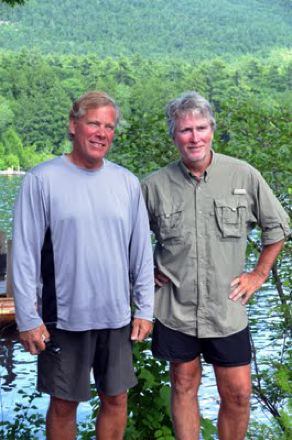
Brian Rooney and Al Freihofer complete their journey
But once the message went from the brain to the body that we wouldn’t have to, everything fell apart.
Rowing 500 miles had been an all-consuming effort. I never lay in my tent reading a book at night, and never had need for a corkscrew.
We rowed until we ate and camped, then got up, rowed, ate and camped again. Al would say goodnight, and I’d hear snoring within 10 seconds.
People have asked whether we’d had any revelations along the way. I was glad to find out that it was still as tough as I had hoped, but that’s not a revelation.
People had asked why we did it, and we couldn’t answer that either. We joked that we were going to keep rowing until we had an answer.
At the end of the day, I have a few words of advice:
- If you go on an adventure, make sure you have a way to make hot coffee in the morning.
- Kill all the mosquitoes in your tent before you go to sleep and sweep out the sand in the morning.
- When rowing upstream, stick to shore and the lower end of the bends. But avoid rowing upstream if you can.
- Point your small boat right at the highest waves and raise your middle finger to French Canadians in cigarette boats.
- Dry bags are, in fact, superior to Hefty SteelSaks.
- A good hat makes the sun bearable and a plate of spaghetti will restore you.
And if you do something this grueling with a friend, do it with a friend who is such a good friend that after the misery, the spoken tension, unspoken tension, the frustration and near disasters he is still a friend who laugh at himself, laugh at you, and be your friend forever.
By Brian Rooney for PeterGreenberg.com. Photos by Brian Rooney and Al Freihofer. Brian Rooney is a former Correspondent for ABC News who has spent a good deal of his life messing around in boats. He lives in Los Angeles and has a summer home on Lake George in the Adirondacks.
Related Links on PeterGreenberg.com:












